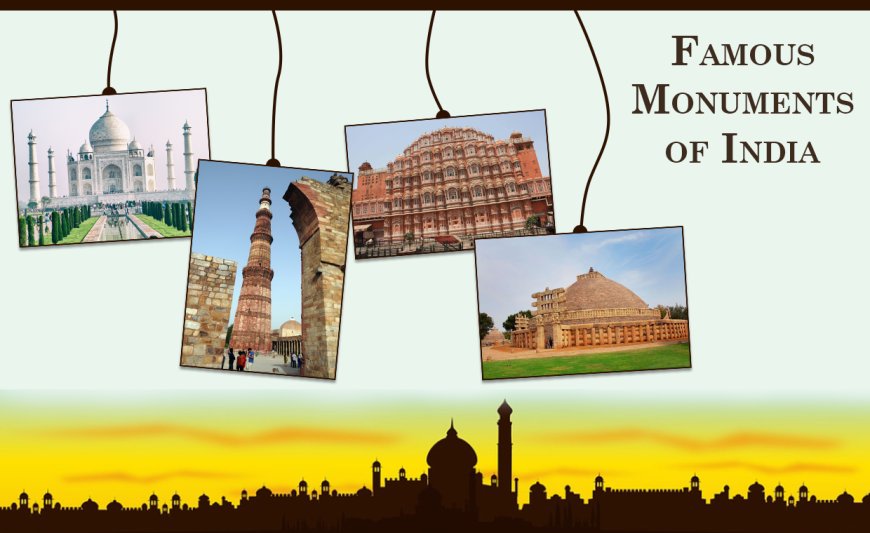Top 25 list of Historical Monuments of India.
India is one of the most beautiful countries in the world and is best known for its colourful culture and fascinating heritage. Its grand monuments, like the Taj Mahal act as strong pillars of the rich and deep history that India possesses.

India is one of the most beautiful countries in the world and is best known for its colourful culture and fascinating heritage. Its grand monuments, like the Taj Mahal act as strong pillars of the rich and deep history that India possesses. From their splendid architecture to a strong legacy, the historical monuments of India speak volumes. Most of these Indian monuments were primarily built under the regime of Rajputana, Dravidian and Mughal emperors. The monuments of India are speaking stones of the glory of its rulers and the brilliance of artisans in ancient India. Due to the incredible beauty of India and the constant efforts of the government in maintaining the heritage sites, India tourism has flourished rapidly witnessing an increase in the number of travellers from all around the world. Some of the well-preserved monuments in the different parts of the country are Red Fort (North), Sun Temple Konark (East), Amer Fort (West) and Charminar (South).
There are a total of 116 monuments in India, spread across 19 states. However, 17 monuments in India are located in Uttar Pradesh.
The Ajanta Caves are India’s oldest monument; approximately 30 stone-cut Buddhist cave monuments developed between 200 B.C. to 650 A.D. It is situated in Aurangabad of Maharashtra State.
Here are some of the most famous and significant historical monuments in India:
- Taj Mahal in Agra, Uttar Pradesh
- Red Fort in Delhi
- Qutub Minar in Delhi
- Humayun's Tomb in Delhi
- Fatehpur Sikri in Agra, Uttar Pradesh
- Jama Masjid in Delhi
- Hawa Mahal in Jaipur, Rajasthan
- Charminar in Hyderabad, Telangana
- Gateway of India in Mumbai, Maharashtra
- Ajanta and Ellora Caves in Maharashtra
- Konark Sun Temple in Odisha
- Khajuraho Group of Monuments in Madhya Pradesh
- Mahabalipuram Group of Monuments in Tamil Nadu
- Hampi Group of Monuments in Karnataka
- Sanchi Stupa in Madhya Pradesh
- Agra Fort in Agra, Uttar Pradesh
- Victoria Memorial in Kolkata, West Bengal
- Golconda Fort in Hyderabad, Telangana
- Brihadeeswara Temple in Thanjavur, Tamil Nadu
- Gwalior Fort in Gwalior, Madhya Pradesh
- Chhatrapati Shivaji Terminus in Mumbai, Maharashtra
- India Gate in Delhi
- Mehrangarh Fort in Jodhpur, Rajasthan
- Meenakshi Amman Temple in Madurai, Tamil Nadu
- Amer Fort in Jaipur, Rajasthan.
These are just a few examples of the many beautiful and historically significant monuments that can be found throughout India.
-
Historical Significance: Monuments provide a tangible link to the past and serve as a reminder of historical events, people, and cultures. They help us understand our history and heritage and allow us to appreciate the achievements and sacrifices of those who came before us.
-
Cultural Identity: Monuments reflect the cultural identity of a place and its people. They embody the values, beliefs, and traditions of a community, and are often an expression of their artistic and architectural heritage.
-
Tourist Attractions: Many monuments have become popular tourist attractions, drawing visitors from all over the world. They contribute to the economy by creating jobs and generating revenue through tourism.
-
Education: Monuments serve as an educational tool, providing opportunities for people to learn about history, culture, art, and architecture. They inspire curiosity, promote learning, and foster a sense of appreciation for our heritage.
-
National Pride: Monuments can also serve as a symbol of national pride and identity. They represent a country's history and culture, and are often associated with national heroes, events, or ideals.
In summary, monuments are important because they connect us to our past, preserve our cultural heritage, educate us, inspire us, and foster a sense of national pride. They remind us of where we come from and help us understand who we are as a people.
-
Architecture: Monuments are often characterized by their architectural style, which reflects the cultural and historical context in which they were built. The design and materials used can also contribute to the monument's durability and longevity.
-
Size and Scale: Monuments can be large or small, but they are often designed to be visually impressive and have a strong presence in the landscape. Their size and scale can also contribute to their cultural and historical significance.
-
Materials: The materials used to construct a monument are an important feature, as they can have symbolic and cultural significance. Monuments may be constructed from materials such as stone, marble, bronze, or other metals.
-
Inscriptions and Symbolism: Monuments often contain inscriptions, symbols, or other decorative elements that convey a message or meaning. These can be religious, political, or cultural in nature, and may be interpreted differently by different groups or individuals.
-
Location: The location of a monument is an important feature, as it can contribute to its historical or cultural significance. Monuments may be located in public spaces, such as parks or plazas, or in more remote or sacred locations.
-
Maintenance and Conservation: The maintenance and conservation of a monument is an important feature, as it helps to ensure its long-term preservation and continued significance. Proper maintenance can also help to protect the monument from damage or deterioration over time.
In summary, the important features of a monument can include its architecture, size and scale, materials, inscriptions and symbolism, location, and maintenance and conservation. Together, these features contribute to the monument's historical, cultural, and symbolic significance.
What's Your Reaction?






















































